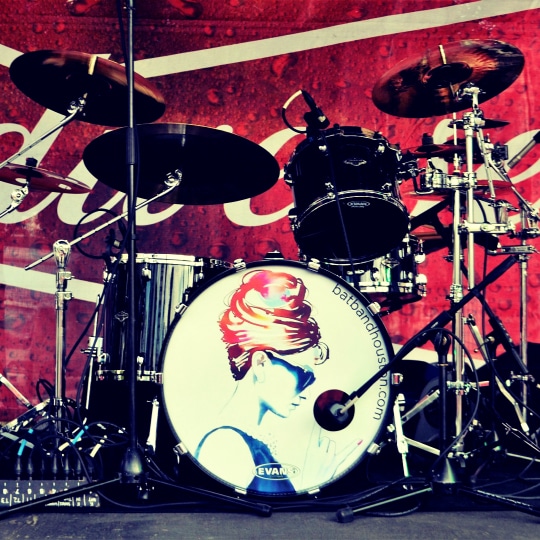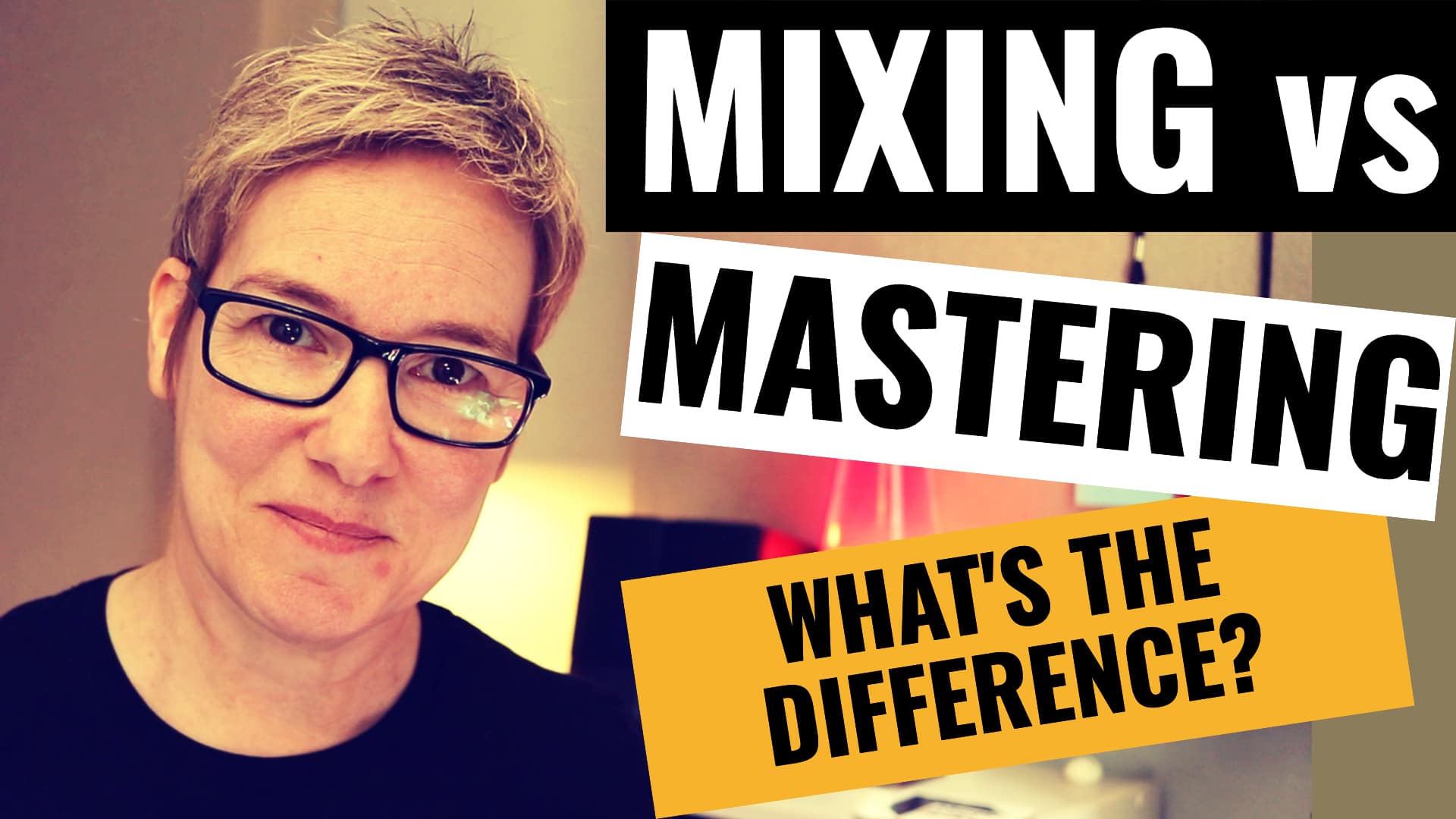Download this article as a handy PDF guide! – CLICK HERE
Mixing drums is my most favourite thing to do whilst mixing rock and indie music. I love the sound of a great drummer, playing a great kit in a great room because, to me, it’s what makes a track more exciting and energetic, more so than heavy distorted guitars, although they come a close second.
But then again, I know I’m a rhythm person. When listening to music some people are led by the lyrics and connect to the song that way. Me, I’m more of a drums and bass kinda girl, followed by the guitars and then the vocal, I tend to hear the rhythm in music first and the lyrics only sink in after several listens.
But that’s by the by.
Today, I want to talk about how to pan drums to get them to sound wide, full and natural in a mix.
Panning Drums – Perspectives
There are a couple of ways to picture drums when panning:
- Drummers perspective
- Audience perspective
Where do you want the drums to be placed in the mix? As the producer or drummer, do you have a strong feeling about this?
Think about it. If you listen to two tracks back to back, that has drums mixed in each perspective, is there one that just doesn’t sound right to you?
When you go into the studio to record your track, think about this and talk to your tracking engineer about it. To be sure this desire doesn’t get lost when you send your song out to be mixed, name the tracks like so:
- OH L HH
- OH R RIDE
This should ensure your drums end up being mixed in drummers perspective. Unless the drummer was left-handed of course! Mind blown…
Panning Explained

So what happens when you turn the pan pot?
The “pan pot” (short for panoramic potentiometer) is just a volume control. It splits the audio signal into left and right channels and when you turn it left, the pot turns up the volume of the left speaker and turns down the volume of the right speaker at the same time.
In early consoles these were three-position switches where you could only choose left, centre or right and this principle is still maintained today by many mix engineers and it’s called LCR panning.
There’s also a thing called panning law. Which, basically, is there to ensure that the volume level remains constant regardless of where the pan pot is placed. Read the Wiki link to learn more.
How To Pan Drums

Step 1
Determine which perspective the drums were recorded in. If the track naming doesn’t look like the method mentioned above, with only OH L and OH R, or, a stereo overheads track, then you’ll have to use your ears.
Pan the “OH L” track all the way left and the “OH R” track all the way right and listen to a section where the toms are being played. Headphones can be better for this.
If the floor tom is louder in the OH L track then it’s audience perspective. If it’s louder in the OH R track then it’s drummers perspective. Additionally, listen to the position of the hi-hat for a further clue as they are at opposite ends of the drum kit.
If you have a stereo OH’s track, then pan it fully wide and do the same assessment.
Step 2
Place the toms in the stereo picture. With the OH’s set hard left and right and at unity gain, slowly bring up the floor tom track in level to something reasonable and match its pan position with the position in the overheads.
Then do the same with the remaining toms.
Step 3
Place the hi-hat in the stereo picture. Like the toms, slowly bring up the hi-hat track until it’s audible, then move the pan pot until you match its position in the overheads.
The hi-hat mic is usually very near the snare drum so you have to make sure the snare isn’t pulled too far out of the centre imaging position when you audition the whole kit.
Many audio engineers keep the hi-hat in the centre position for this reason but I like to take it a little off centre to keep it out of the way of the vocal.
Step 4
Lastly, bring up the kick and snare tracks and keep them in the centre position. Set them to an approximate volume and get a rough balance of the kit as a whole.
Panning in Mono

Mono compatibility is incredibly important, even today. With millions of people consuming music on mobile phone speakers or SONOS speakers dotted around the house, it’s not something that should be ignored when mixing music.
By setting the initial balance of the drums during mixing (and actually, the whole mix) in mono means you don’t get a false sense of separation given by stereo panning. Set the panning whilst monitoring in mono and on one speaker if possible as the levels can change because of the “pan law” characteristics in your particular DAW.
By doing this, you avoid that familiar occurrence when checking your mix in mono, later down the line, and certain elements of your mix drop in level significantly, like those hard-panned guitars in the choruses for example. Getting on top of this early by setting your static mix in mono can save you time and frustration.
Use EQ to separate instruments whilst in mono and you’ll have greater clarity, depth and width when you do eventually go stereo.
Set your monitor controller or interface to mono, then, set your panning in the DAW to properly utilise this technique.
This can also highlight phase cancellations brought about by using width plugins or multiple mics (like on drums!). There’s a great short video here that demonstrates what can happen when you don’t check your mix in mono, courtesy of Noise Floor A/V.
How Wide?

I’ve heard many opinions about how wide to take your overheads and toms when mixing drums.
One school of thought is that, in reality, when listening to a drummer on stage the sound isn’t that wide at all. In fact, it’s more or less mono.
Another thought is that by panning the drums using the LCR method mentioned above, can give the drums an artificial sense of super width making them sound unnatural and can also introduce phase issues.
Personally, I find that by keeping the drums slightly narrowed, it allows the other instruments to dominate the choruses by exploding fully wide, like the guitars in a rock song for example.
Conclusion
Often, when mixing drums, panning the individual drums correctly leads to a clearer, more focused mix. It’s worth giving the mono panning trick a try in your next mix and let me know if it worked for you.
If you are interested in having me mix your music and are wondering how to prepare your mix then check out my blog post- how-to-prepare-your-track-for-professional-mixing
If you want to know more about my online mixing service, then you can learn more on my mixing page or contact me here.
Or maybe you’d like help mixing your own music? If so, you can read about how to get better results at home by clicking here – 10-tips-for-mixing-your-own-music
Have any questions about panning drums?
Do you find mixing drums a challenge?
Drop them in the comments below and then, don’t forget to sign up to my newsletter to get notified when a new post is published and to get subscriber-only special offers, more top mixing tips and links to exclusive FREE mixing and mastering downloads!






3 thoughts on “Panning Drums For Clarity And Focus”
Hi Sara,
The youtube link doesn’t work for me, it says the video is private.
PS. The PDF guides you make are really great, would you consider doing one of those for sidechain compression and dynamic EQ and that sort of stuff? 🙂
YouTube links not working could be because of an unaccepted cookie preference when you clicked the cookie notification bar
Thank you very much for your tips,they are very helpful.